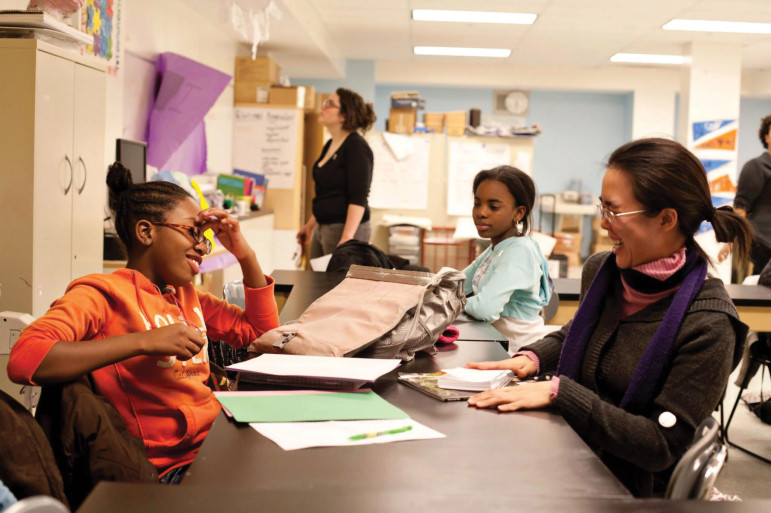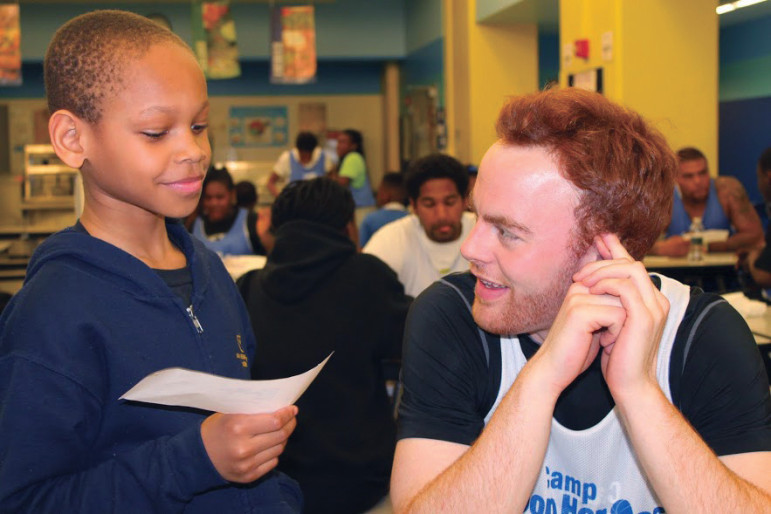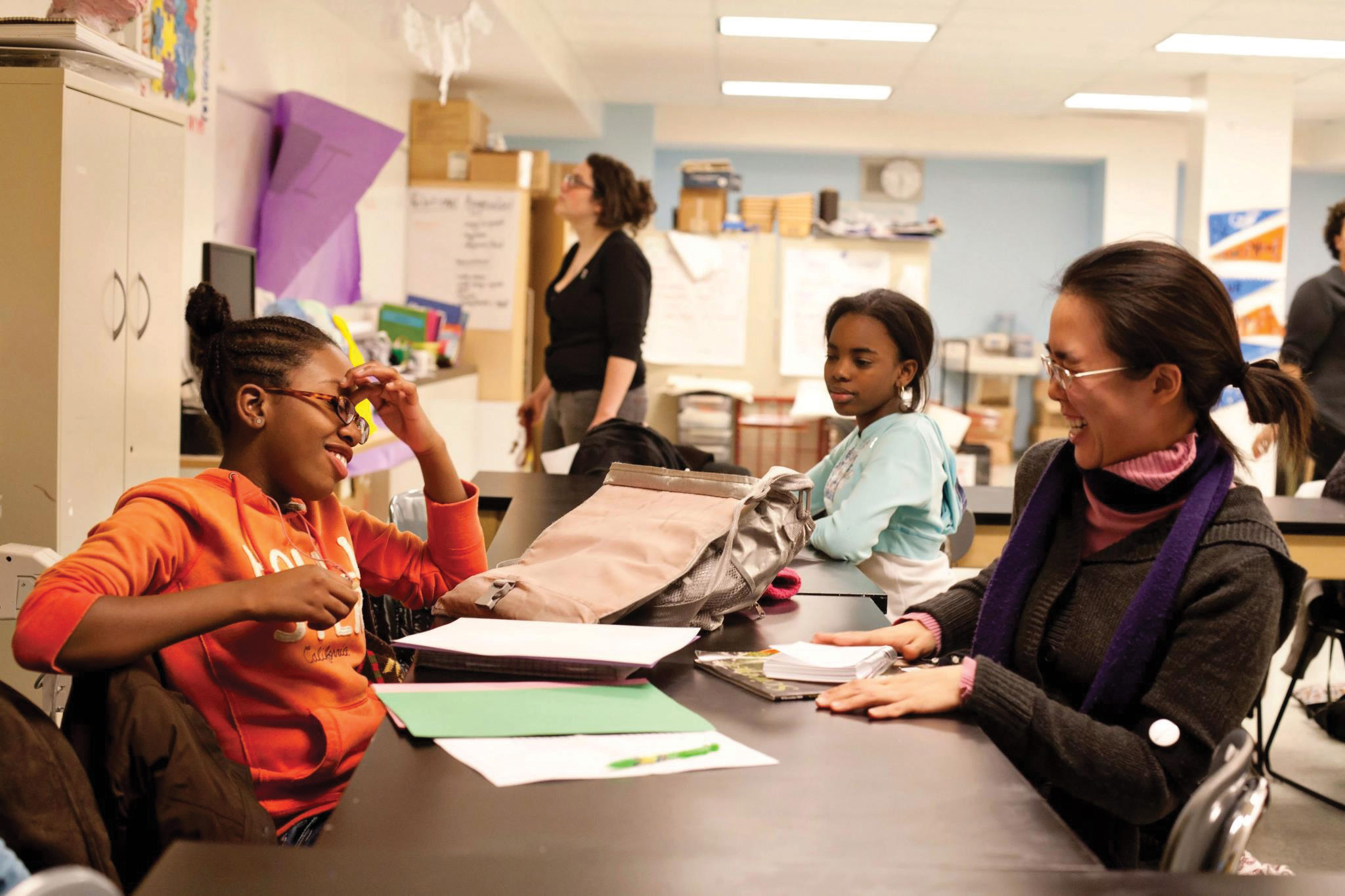
Girls Inc.
A teenage girl and a Girls Inc. volunteer participate in a mentoring session in Brooklyn, N.Y.
The nonprofit Communities In Schools relies on some 60,000 adult volunteers around the U.S. to mentor students in kindergarten through high school for two-year stints.
YouthBuild USA taps into more than 1,100 mentors who work for 18 months alongside young people building environmentally friendly housing and other projects for low-income residents.
At Girls Inc.’s 90 affiliates, thousands of volunteers help shepherd girls from elementary school through high school to become successful young adults.
These three thriving youth organizations’ programs are among a multitude that depend heavily on volunteers to help carry out their missions: For the yearlong span ending in September 2013, more than 16 million people volunteered for educational or youth service-related organizations, according to the U.S. Bureau of Labor Statistics.
What distinguishes the best volunteer programs from the rest?
Leaders of youth organizations point to a handful of key elements:
- Finding and recruiting enthusiastic volunteers who are well-suited for their roles.
- Screening prospective volunteers. Beyond the obvious, like doing criminal background checks, youth organization leaders stress the importance of a good match between volunteers’ interests and expertise and the volunteer roles.
- Setting clear boundaries (like bans on being alone with children or connecting with them through social media).
- Providing orientation and ongoing training.
- Rewarding volunteers to recognize them for their work.
Make clear to volunteers how their work fits into your organization’s mission, said Mei Cobb, director of volunteer engagement at the United Way Worldwide.
Thus, Cobb said, volunteers might be told: “By working with us, you’re helping a young person get into college or be the first in their family to attend college, or you’re helping by tutoring these young people in algebra. That’s one of the key predictors for high school success.”
Getting started
It’s imperative to detail the expectations for volunteers and to train them well.
“We think orientation and ongoing training are just key,” said Patricia Driscoll, chief operating officer for New York City-based Girls Inc. “The worst thing you can do is say, ‘Oh, yeah, show up Tuesday at 3 o’clock,’ and just kind of throw them in and say, ‘Here’s a bunch of girls. Make yourself at home.’”
Girls Inc.’s orientation provides an overview of affiliates and their roles in the national organization, its philosophy, a volunteer job description and developmental issues for girls at different ages. And all the volunteers get a handbook outlining roles and expectations.
Communities In Schools, based in Arlington, Va., is developing “pocket guides” for volunteer mentors that will include tips like conversation starters to help break the ice with students and get them talking about their post-high school plans.
Girl Scouts of the USA, based in New York City, has launched an online “personalized volunteer toolkit” to help its 890,000 adult volunteers, who serve as troop leaders, cookie moms and dads, program experts, community spokespeople and mentors and role models to girls.
YouthBuild, based in the Boston suburb of Somerville, Mass., and operating in 46 states, pairs mentors with groups of young mentees, both of whom receive training from staff for three months. Then mentors work for a year one-on-one with their charges, who earn a GED or high school diploma while in the program.
While focusing on volunteer orientation, it’s important to remember that staff also need to be kept informed — and inspired — about how volunteers fit into the program or organization’s big picture.
Otherwise, the staff may view volunteers as nuisances who need to be kept occupied so they stay out of the way, said Carla Sanger, president and CEO of LA’s Best, an after-school program operating in 195 Los Angeles elementary schools.

After-School All-Stars
A volunteer mentor for After-School All-Stars chats with a student in New York City.
Recruitment
For YouthBuild, as for some other youth organizations, corporate volunteerism has played an increasingly important role. In addition to its more than 1,100 mentors nationwide, YouthBuild has about 5,500 other short-term volunteers each year, many of them from corporations that encourage employee volunteerism.
Like some other youth organizations, YouthBuild has faced challenges in attracting adult males of color to mentor youths.
But Tommy McClam, director of mentoring with YouthBuild USA, said, “We’ve actually been able to overcome that by getting the mentors from the communities where the young people are actually living, so we end up with a mentor pool that resembles young people they’re working with.”
For Girls Inc., matching youths’ needs with adults’ interests and capabilities means volunteers must share the organization’s value of empowering girls and building on their strengths.
“This idea that that ‘I’m coming in as a volunteer to save these poor girls’ — and literally, whether they be economically poor or however they’re disadvantaged — would really not fit with our philosophy, and I don’t think it would truly fit with any youth-development organization,” said Driscoll of Girls Inc.
To recruit some of the best and the brightest volunteers, organization leaders say to start close to your program and its existing pool of volunteers. Ask each of them to recommend three others, and you’re likely to attract some good candidates, said YouthBuild’s McClam.
When Lynette Bynoe began working as director of the volunteer program at LA’s Best 11 years ago, she said, she recruited volunteers mainly from the ranks of college students studying to be teachers. But the program has branched out considerably and partnered with California corporations seeking opportunities for their employees.
Not long ago, employees of an aerospace company worked with fourth- and fifth-graders at LA’s Best to explore the components of a basic model. Another group of students toiled with engineers from the El Segundo, Calif.-based Mattel Inc. to try to make Hot Wheels cars loop twice on a Hot Wheels track.
After-School All-Stars, which offers free after-school programs that serve some 90,000 predominantly middle school students in 15 U.S. cities, recruits among high school and college students in addition to adult volunteers.
Student volunteers and high school guidance counselors encourage kids in After-School All-Stars’ dropout-prevention program. Employees of nonprofits assist the young students in preparing for standardized tests and applying for financial aid. Professionals speak to students about careers in sports marketing, advertising, government, finance and technology.
The young All-Stars also plan community service in which adults participate alongside the kids in volunteer activities like the American Cancer Society’s Relay for Life as well as visits to children’s hospitals to deliver gifts, helping out at homeless shelters and doing maintenance at the homes of elderly people.
Evaluation
What about evaluating your volunteers and your volunteer program?
Irv Katz, president and CEO of the National Human Services Assembly, a Washington-based association of some of the nation’s leading nonprofits, said in an email: “Evaluation can be built in from the beginning in the sense that it is all about clear expectations of the organization and the volunteer upfront, and formal assessment or indicator checks along the way that expectations were met: Did the project get done as intended? Were the volunteer’s objectives for volunteering met? Was it a productive and agreeable experience for all?
“We’ve engaged volunteers and unpaid interns in a variety of ways. It’s pretty obvious when the engagement is working well. The individual is productive and excited about the work and the mission with which it is associated. The staff and board respect and treat the volunteer as a member of the team. The volunteer feels connected, and is connected with the organization and its people.”
Recognition and retention
As for rewarding and retaining volunteers, leaders of youth organizations turn to time-tested methods. They hold events and ceremonies to celebrate volunteers’ accomplishments. They give out plaques, pins or tote bags with an organization’s logo on them. They provide little perks that can make a big difference like mass transit passes.
Some organizations let the kids who benefit from volunteers’ work thank them publicly at events or through cards and gifts like artwork.
The United Way’s Cobb knows first-hand how much gifts from children can mean to volunteers — and not only because of her role as the organization’s volunteer engagement director.
Last school year, students she tutored in reading at an elementary school in the rural community of Davidsonville, Md., made her a picture of a flower and wrote on its petals characteristics about her they like, such as her patience and her ability to make learning fun.
Today, the picture of the flower hangs in Cobb’s office in the Washington, D.C., suburb of Alexandria, Va., and she thinks of the students she tutored whenever she looks at it.

























